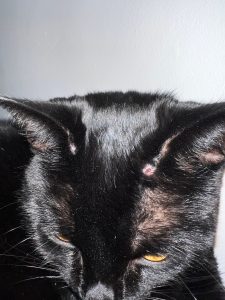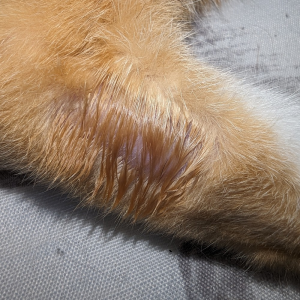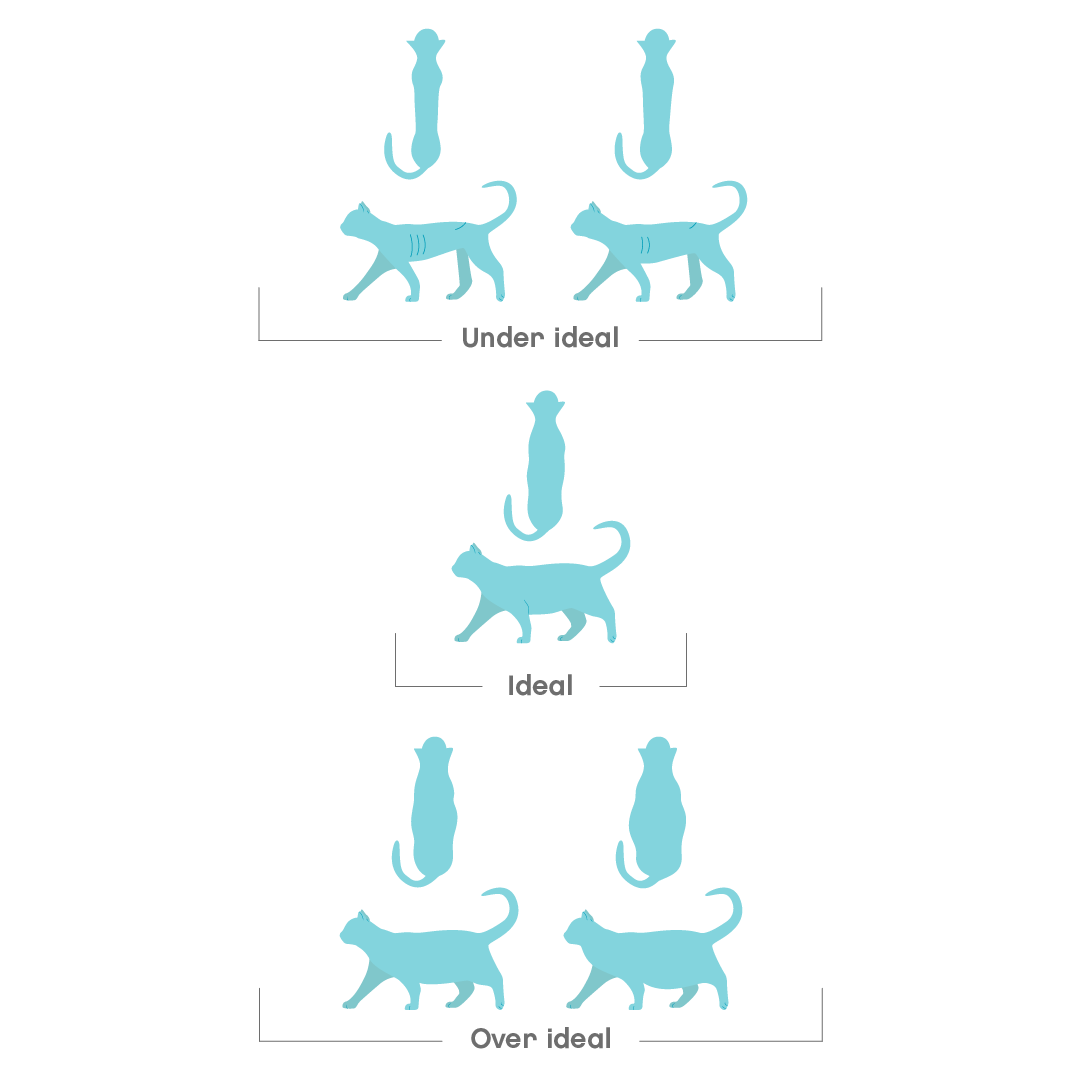Hot spots are localised areas of skin infection. They are usually not dangerous, easy to treat, and can affect cats of any age.
Hot spots in cats are the same type of skin condition as in dogs but are less common. The skin appears wet and red, and it can be painful. Hot spots are also known as acute moist dermatitis or pyotraumatic dermatitis. They are usually caused by over-grooming (licking or biting) of the skin due to an underlying problem such as fleas or an allergy.
Overview
What are hot spots in cats?
Hot spots are localised skin infections that can occur anywhere on the body, usually due to over-grooming.
- They appear suddenly as moist, swollen, and painful areas of skin
- Usually caused by biting or licking at an area excessively
- Often start as a mild infection but can get worse and spread quickly if not treated promptly
- A hot spot can be much worse than it looks; shaving the hair may reveal a larger area of skin that is affected.
- Hot spots are often linked to allergies. Anything that causes your cat to itch can cause a hot spot.
- They can happen at any time of the year but are more common in humid weather

- A small hot spot on the top of the head
The most common causes of hot spots in cats are
- Fleas
- Allergies (Food allergies, environment, Flea allergy dermatitis)
- Wounds from trauma
- Stress or Pain
- Matted fur
- Ear disease
Left untreated, hot spots can worsen and become harder to treat. Speak to a vet if your cat shows any signs of a hot spot. Our Joii team are available 24 hours a day for advice.
Symptoms
Symptoms of hot spots in cats
Hot spots are usually localised patches of skin infection. They can appear anywhere on the body but are more common around the head, neck, and tummy.
The skin can appear
- Swollen and warm
- Inflamed (red)
- Moist, oozing, or wet
- Painful
- Smelly or crusty areas
- Bald patches

- Cats often lick these areas excessively and the skin appears moist
Other signs include
- Constant licking, scratching or biting at the affected area of skin
- Vocalisation
- Lethargy
- Reduced eating and drinking
Risk
Are some cats at more risk of hot spots than others?
Any cat can develop hot spots but the following factors can increase the risk
- Cats with allergies
- Elderly or ill cats: tend to groom less, so there is more risk of mats and hot spots because of this.
- Long-haired cats and those with dense fur
- Obesity: folds or flaps of skin trap moisture and increase the risk of a hot spot.
Diagnosis
How are hot spots diagnosed in cats?
Hot spots are usually diagnosed based on their appearance. Further tests may be needed if the hot spot is not resolving or if there is an underlying disease.
Tests for underlying conditions
- Skin swab, scrapes, hair plucks, or biopsy
- Ear flush and swab
- Blood and urine tests
- A strict food trial to check for allergies in the food
- Imaging, such as x-rays, if pain is suspected
Vet treatment
Vet treatment for hot spots in cats
Treatment of hot spots may include the following
- Shaving the hair to evaluate how deep and how much skin is affected. Also improves circulation of air for better healing.
- Cleaning the affected skin with an antimicrobial solution
- Sedation or general anaesthesia, depending on how severe the lesion is
Prescription medications include
- Antibiotics: many different forms, such as tablets, liquids, injections, creams, or shampoo
- Anti-itch medications: there are many different types of these, and your vet will work with you to find the best solution for your cat. Includes steroids and Atopica.
Medications for underlying conditions include
- Parasite treatments: for fleas and different types of mites
- Antifungal medication
- Ear drops for ear infections
- Pain relief
Home treatment
How to look after a cat with a hot spot at home
Always seek advice from a vet if you suspect your cat has a hot spot; they can be much deeper than they look.
You can help at home by
- Use a buster collar or protective suit to prevent further self-trauma
- Keep the affected area as clean and dry as possible.
- Use over the counter shampoo, mousse, or cream. Speak to your vet to find out the best products to use.
- Skin supplements containing omega oils that can help protect the skin barrier.
- Use ear cleaners that can help with mild irritations or infections in the ears.
- Do a diet trial with a novel or hydrolysed protein to check for food allergies. A novel protein is one that your cat has never eaten before. All other food and treats need to be cut out during a strict trial lasting 6-8 weeks before assessing the results.
- Treat all pets in the household with a vet recommended parasite control for fleas and mites.
Prevention
Tips on how to prevent hot spots in cats
- Use regular parasite control that covers fleas, mites, ticks, and worms.
- Regularly clean your cat’s bedding, collar, and bowls.
- Brush your cat and check for any abnormal areas of skin at least once a week.
- Feed your cat high-quality, complete food for their age and lifestyle. Some brands also have a special skin care range with high omega oil levels.
- Skin supplements containing omega oils are useful for cats with skin diseases.
- Get your cat checked over with a vet as soon as possible if they become itchy to help prevent self-trauma to the skin.
- Keep your cat at a healthy weight. See our body condition scoring chart below.
Body Condition Score (BCS) is a scale that gives a practical evaluation of the fat coverage of your cat’s body. By checking how easy or not it is to feel certain bony areas of the body, a score is then produced. There are several scales, from 1 to 5 or 1 to 9. The ideal body condition lies in the middle, so either 3/5 or 5/9. The body areas normally checked for fat coverage are: 1. ribs and spine 2. hips and shoulders 3. waist Here are a few tips on how to do it. With your pet in a standing position:
Body Condition Scoring (BCS) in cats

Is my family at risk of catching hot spots?
Hot spots themselves are not contagious to humans. The common underlying problems, such as allergies, are also not contagious to humans. There are some lesser common causes, such as mange or ringworm, that may be contagious to humans. Seek help from your doctor if you have any concerns.
When to worry
When to worry about hot spots in cats
Seek help from your local vet practice if
- Your cat is extremely itchy
- Your cat’s hot spot is not resolving after treatment
Call us and speak to one of our Joii Vets if
- You have any questions about skin care products that you can use without a prescription
- Your cat has a skin problem and you are not sure what to do
- You need advice about weight loss in cats








